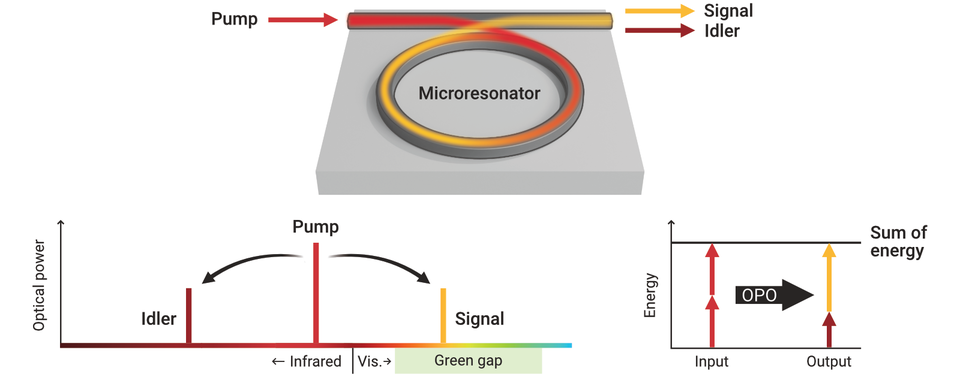
Credit:
S. Kelley/NIST
It is not easy, Green.
For years, scientists have been constructing small, high-quality lasers that produce red and blue light. But the method they typically use—feeding electrical current into semiconductors—hasn’t worked well for building tiny lasers that emit light at yellow and green wavelengths. Researchers call the lack of stable miniature lasers in this region of the visible light spectrum the “green gap.” Closing this gap opens up new possibilities in underwater communications, medical treatments, and more.
Green laser pointers have been around for 25 years, but they only produce light in a narrow green spectrum and are not integrated into chips where they could perform useful tasks in conjunction with other devices.

Credit:
S. Kelley/NIST
Now scientists at the National Institute of Standards and Technology (NIST) have closed this gap by modifying a tiny optical component: a ring-shaped microresonator that is small enough to fit on a chip.
A miniature source of green laser light could improve underwater communications, since water in most aquatic environments is nearly transparent to blue-green wavelengths. Other potential applications include full-color laser projection displays and laser treatment of diseases including diabetic retinopathy, a proliferation of blood vessels in the eye.
Compact lasers in this wavelength range are also important for applications in quantum computing and communications, as they could potentially store data in qubits, the fundamental unit of quantum information. Currently, these quantum applications rely on lasers that are larger, heavier and more powerful, limiting their uses outside the laboratory.
For several years, a team led by Kartik Srinivasan of NIST and the Joint Quantum Institute (JQI), a research partnership between NIST and the University of Maryland, has used silicon nitride microresonators to convert infrared laser light into other colors. When infrared light is pumped into the ring-shaped resonator, the light circles thousands of times until it reaches an intensity high enough to interact strongly with the silicon nitride. This interaction, known as optical parametric oscillation (OPO), creates two new wavelengths of light called the idler and signal wavelengths.

Credit:
S. Kelley/NIST
In previous studies, the researchers produced a few individual colors of visible laser light. Depending on the dimensions of the microresonator, which determine the colors of the light produced, the scientists produced red, orange and yellow wavelengths, as well as a wavelength of 560 nanometers, right on the border between yellow and green light. However, the team could not produce the full range of yellow and green colors that would be needed to close the green gap.
“We didn’t want to limit ourselves to covering just a few wavelengths,” said Yi Sun, a NIST scientist and collaborator on the new study. “We wanted to cover the entire wavelength range of the gap.”
To close the gap, the team modified the microresonator in two ways. First, the scientists thickened it slightly. By changing its dimensions, the researchers could more easily generate light that penetrated deeper into the green gap, down to wavelengths as small as 532 nanometers (billionths of a meter). With this extended range, the researchers covered the entire gap.
In addition, the team exposed the microresonator to more air by etching away some of the underlying silicon dioxide layer. This resulted in the output colors being less sensitive to the microring dimensions and the infrared pump wavelength. The lower sensitivity gave the researchers more control in generating slightly different green, yellow, orange and red wavelengths from their device.

Credit:
S. Kelley/NIST
As a result, the researchers found they could generate and fine-tune over 150 different wavelengths across the green gap. “Previously, we could make big changes – from red to orange to yellow to green – to the laser colors we could produce with OPO, but it was difficult to make small adjustments within each of those color bands,” noted Srinivasan.

Credit:
S. Kelley/NIST
The scientists are now working on increasing the energy efficiency of generating the green gap laser colors. Currently, the output power is only a few percent of the power of the input laser. Better coupling between the input laser and the waveguide that guides the light into the microresonator, as well as better methods for extracting the generated light, could significantly increase efficiency.
The researchers, including Jordan Stone and Xiyuan Lu of JQI and Zhimin Shi of Meta’s Reality Labs Research in Redmond, Washington, published their findings online on August 21 in Light: Science and Applications.
Paper:
Yi Sun, Jordan Stone, Xiyuan Lu, Feng Zhou, Junyeob Song, Zhimin Shi, and Kartik Srinivasan. Advancing on-chip optical parametric Kerr oscillation toward coherent applications bridging the green gap. Light: Science and Applications. Published online on August 21, 2024. DOI: 10.1038/s41377-024-01534-x.

